Deformation Behavior of an Extruded 7075 Aluminum Alloy at Elevated Temperatures
Abstract
1. Introduction
2. Experimental Section
2.1. Materials
2.2. High-Temperature Compression Test
2.3. Characterization
3. Experimental Results
4. Discussion
4.1. Dynamic Softening Behavior
4.2. Anisotropic Deforming Behavior
5. Conclusions
- (1)
- The stress level of the 7075 alloy bar decreased with an increase in compression temperature and a decrease in strain rate. In addition, the extruded 7075 aluminum alloy exhibited anisotropic mechanical behavior at a deformation temperature of 300 °C. However, no evident anisotropy was observed at a deformation temperature of 400 °C.
- (2)
- During compression at 300 °C, dynamic recovery occurred. The dislocation density decreased at higher compression temperatures; simultaneously, with a decrease in strain rate, the density of dislocations exhibited a decreasing trend. Moreover, when compressed at 400 °C, a certain number of equiaxed grains were found, which demonstrated the occurrence of dynamic recrystallization. At the same time, the precipitates became coarser during compression. The softening effect, including dynamic recovery, dynamic recrystallization, and precipitate coarsening, contributed to a decrease in strength.
- (3)
- When compressed at 300 °C, the extruded 7075 alloy bar exhibited anisotropic strength. This can be explained by the elongated grains and the {011} <211> brass component. When compressed at 400 °C, no evident anisotropic mechanical properties were observed. Higher compression temperatures can produce more energy in order to activate and promote slipping. In addition, dynamic recrystallization results in a change in grain shape and the evolution of the orientation.
Author Contributions
Funding
Institutional Review Board Statement
Informed Consent Statement
Data Availability Statement
Conflicts of Interest
References
- Berlanga-Labari, C.; Biezma-Moraleda, M.V.; Rivero, P.J. Corrosion of cast aluminum alloys. Metals 2020, 10, 1384. [Google Scholar] [CrossRef]
- Noga, P.; Skrzekut, T.; Wędrychowicz, M.; Węglowski, M.S.; Węglowska, A. Research of friction stir welding (FSW) and electron beam welding (EBW) process for 6082-T6 aluminum alloy. Materials 2023, 16, 4937. [Google Scholar] [CrossRef] [PubMed]
- Bhatta, L.; Pesin, A.; Zhilyaev, A.P.; Tandon, P.; Kong, C.; Yu, H. Recent development of superplasticity in aluminum alloys. Metals 2020, 10, 77. [Google Scholar] [CrossRef]
- Vatansever, F.; Erturk, A.T.; Karabay, S. Improving mechanical properties of AlSi10Mg aluminum alloy using ultrasonic melt treatment combined with T6 heat treatment. Kov. Mater. 2019, 57, 33–43. [Google Scholar] [CrossRef]
- Bamberg, P.; Gintrowski, G.; Liang, Z.; Schiebahn, A.; Reisgen, U.; Precoma, N.; Geffers, C. Development of a new approach to resistance spot weld AW-7075 aluminum alloys for structural applications: An experimental study–Part 1. J. Mater. Res. Technol. 2021, 15, 5569–5581. [Google Scholar] [CrossRef]
- Younis, H.B.; Kamal, K.; Sheikh, M.F.; Hamza, A. Prediction of fatigue crack growth rate in aircraft aluminum alloys using optimized neural networks. Theor. Appl. Fract. Mec. 2022, 117, 103196. [Google Scholar] [CrossRef]
- Baek, M.S.; Euh, K.; Lee, K.A. Microstructure, tensile and fatigue properties of high strength Al 7075 alloy manufactured via twin-roll strip casting. J. Mater. Res. Technol. 2020, 9, 9941–9950. [Google Scholar] [CrossRef]
- Choi, Y.; Lee, J.; Panicker, S.S.; Jin, H.K.; Panda, S.K.; Lee, M.G. Mechanical properties, springback, and formability of W-temper and peak aged 7075 aluminum alloy sheets: Experiments and modeling. Int. J. Mech. Sci. 2020, 170, 105344. [Google Scholar] [CrossRef]
- Hattori, C.S.; Almeida, G.F.C.; Gonçalves, R.L.P.; Santos, R.G.; Souza, R.C.; da Silva, W.C., Jr.; Couto, A.A. Microstructure and fatigue properties of extruded aluminum alloys 7046 and 7108 for automotive applications. J. Mater. Res. Technol. 2021, 14, 2970–2981. [Google Scholar] [CrossRef]
- Whalen, S.; Olszta, M.; Reza-E-Rabby, M.; Roosendaal, T.; Wang, T.; Herling, D.; Overman, N. High speed manufacturing of aluminum alloy 7075 tubing by Shear Assisted Processing and Extrusion (ShAPE). J. Manuf. Process. 2021, 71, 699–710. [Google Scholar] [CrossRef]
- Otani, Y.; Sasaki, S. Effects of the addition of silicon to 7075 aluminum alloy on microstructure, mechanical properties, and selective laser melting processability. Mat. Sci. Eng. A 2020, 777, 139079. [Google Scholar] [CrossRef]
- Peterson, L.A.; Horstemeyer, M.F.; Lacy, T.E.; Moser, R.D. Experimental characterization and constitutive modeling of an aluminum 7085-T711 alloy under large deformations at varying strain rates, stress states, and temperatures. Mech. Mater. 2020, 151, 103602. [Google Scholar] [CrossRef]
- Shiraiwa, T.; Briffod, F.; Enoki, M. Prediction of fatigue crack initiation of 7075 aluminum alloy by crystal plasticity simulation. Materials 2023, 16, 1595. [Google Scholar] [CrossRef]
- Alewi, D.; Murdoch, H.; Magagnosc, D.; Lemmen, K.; Karaca, H.; Rottmann, P. Depth-dependent microstructure and mechanical properties of hot rolled AA7075. Mat. Sci. Eng. A 2024, 892, 146056. [Google Scholar] [CrossRef]
- Noga, P.; Piotrowicz, A.; Skrzekut, T.; Zwoliński, A.; Strzępek, P. Effect of various forms of aluminum 6082 on the mechanical properties, microstructure and surface modification of the profile after extrusion process. Materials 2021, 14, 5066. [Google Scholar] [CrossRef] [PubMed]
- Scharifi, E.; Nietsch, J.A.; Quadfasel, A.; Weidig, U.; Steinhoff, K. Effect of thermo-mechanically activated precipitation on the hot deformation behavior of high strength aluminum alloy AA7075. Metals 2022, 12, 1609. [Google Scholar] [CrossRef]
- Liu, W.; Zhao, H.; Li, D.; Zhang, Z.; Huang, G.; Liu, Q. Hot deformation behavior of AA7085 aluminum alloy during isothermal compression at elevated temperature. Mat. Sci. Eng. A 2014, 596, 176–182. [Google Scholar] [CrossRef]
- Cai, J.; Chen, L.; Yang, J.; Wang, W.; Ding, B.; Yang, Q.; Wang, K. Hot Deformation behavior and microstructure evolution of high-strength Al-Zn-Mg-Cu alloy. Metals 2022, 12, 1695. [Google Scholar] [CrossRef]
- Lei, C.; Wang, Q.; Ebrahimi, M.; Li, D.; Tang, H.; Zhang, N.; Cai, H. Hot Deformation behavior and processing maps of an as-cast Al-5Mg-3Zn-1Cu (wt%) alloy. Materials 2023, 16, 4093. [Google Scholar] [CrossRef] [PubMed]
- Guo, R.; Liang, D.; Qin, G. The flow stress behavior and physical-based constitutive model for as-quenched Al-Zn-Mg-Cu alloy. Materials 2023, 16, 4982. [Google Scholar] [CrossRef] [PubMed]
- Ke, B.; Ye, L.; Tang, J.; Zhang, Y.; Liu, S.; Lin, H.; Liu, X. Hot deformation behavior and 3D processing maps of AA7020 aluminum alloy. J. Alloy. Compd. 2020, 845, 156113. [Google Scholar] [CrossRef]
- Wu, S.; Zhu, B.; Jiang, W.; Qiu, H.; Guo, Y. Hot deformation behavior and microstructure evolution of a novel Al-Zn-Mg-Li-Cu alloy. Materials 2022, 15, 6769. [Google Scholar] [CrossRef]
- Sun, Z.C.; Zheng, L.S.; Yang, H. Softening mechanism and microstructure evolution of as-extruded 7075 aluminum alloy during hot deformation. Mater. Charact. 2014, 90, 71–80. [Google Scholar] [CrossRef]
- Luo, L.; Liu, Z.; Bai, S.; Zhao, J.; Zeng, D.; Wang, J.; Hu, Y. Hot deformation behavior considering strain effects and recrystallization mechanism of an Al-Zn-Mg-Cu Alloy. Materials 2020, 13, 1743. [Google Scholar] [CrossRef]
- Guo, Y.; Zhang, M.; Wang, Z.; Wang, S.; Liu, C.; Qian, L.; Zhao, H. Effects of cold temperatures, strain rates and anisotropy on the mechanical behavior and fracture morphology of an Al–Zn–Mg–Cu alloy. Mat. Sci. Eng. A 2021, 806, 140691. [Google Scholar] [CrossRef]
- Li, Y.; Xu, G.; Liu, S.; Wang, B.; Peng, X. Study on anisotropy of Al-Zn-Mg-Sc-Zr alloy sheet. Mater. Charact. 2021, 172, 110904. [Google Scholar] [CrossRef]
- Srinivasan, N.; Velmurugan, R.; Bhaskar, L.K.; Singh, S.K.; Pant, B.; Kumar, R. The role of brass texture on the deformation response of 7075-T651 aluminum alloy under equi-biaxial tension. Mat. Sci. Eng. A 2021, 812, 141133. [Google Scholar] [CrossRef]
- Raja, N.; Kumar, A.; Patel, S.K. Hot deformation and microstructural evolution of ultrasonically fabricated as-cast Al-7.3 Zn-2.2 Mg-2 Cu alloy. Mater. Charact. 2023, 206, 113404. [Google Scholar] [CrossRef]
- Österreicher, J.A.; Tunes, M.A.; Grabner, F.; Arnoldt, A.; Kremmer, T.; Pogatscher, S.; Schlögl, C.M. Warm-forming of pre-aged Al-Zn-Mg-Cu alloy sheet. Mater. Design 2020, 193, 108837. [Google Scholar] [CrossRef]
- Dubey, R.; Jayaganthan, R.; Ruan, D.; Gupta, N.K.; Jones, N.; Velmurugan, R. Energy absorption and dynamic behaviour of 6xxx series aluminium alloys: A review. Int. J. Impact Eng. 2023, 172, 104397. [Google Scholar] [CrossRef]
- Qiu, S.; Xia, E.; Liu, L.; Ye, T.; Liu, J.; Tang, J.; Wu, Y. Tensile behavior and microstructure evolution of an extruded 6082 aluminum alloy sheet at high temperatures. Metals 2023, 14, 7. [Google Scholar] [CrossRef]
- Frodal, B.H.; Thomesen, S.; Børvik, T.; Hopperstad, O.S. On fracture anisotropy in textured aluminium alloys. Int. J. Solids Struct. 2022, 244, 111563. [Google Scholar] [CrossRef]
- Maizza, G.; Pero, R.; Richetta, M.; Montanari, R. Continuous dynamic recrystallization (CDRX) model for aluminum alloys. J. Mater. Sci. 2018, 53, 4563–4573. [Google Scholar] [CrossRef]
- Attarilar, S.; Ebrahimi, M.; Hsieh, T.H.; Uan, J.Y.; Göde, C. An insight into the vibration-assisted rolling of AA5052 aluminum alloy: Tensile strength, deformation microstructure, and texture evolution. Mat. Sci. Eng. A 2021, 803, 140489. [Google Scholar] [CrossRef]
- Thomesen, S.; Hopperstad, O.S.; Børvik, T. Anisotropic plasticity and fracture of three 6000-series aluminum alloys. Metals 2021, 11, 557. [Google Scholar] [CrossRef]
- Yang, Y.; Xie, Z.; Zhang, Z.; Li, X.; Wang, Q.; Zhang, Y. Processing maps for hot deformation of the extruded 7075 aluminum alloy bar: Anisotropy of hot workability. Mat. Sci. Eng. A 2014, 615, 183–190. [Google Scholar] [CrossRef]
- Lim, H.; Lee, M.G.; Kim, J.H.; Adams, B.L.; Wagoner, R.H. Simulation of polycrystal deformation with grain and grain boundary effects. Int. J. Plast. 2011, 27, 1328–1354. [Google Scholar] [CrossRef]
- Raabe, D.; Roters, F. Using texture components in crystal plasticity finite element simulations. Int. J. Plast. 2004, 20, 339–361. [Google Scholar] [CrossRef]
- Bois-Brochu, A.; Blais, C.; Goma, F.A.T.; Larouche, D. Modelling of anisotropy for Al-Li 2099 T83 extrusions and effect of precipitate density. Mat. Sci. Eng. A 2016, 673, 581–586. [Google Scholar] [CrossRef]
- Ye, T.; Li, L.X.; Liu, X.; Liu, W.H.; Guo, P.C.; Tang, X. Anisotropic deformation behavior of as-extruded 6063-T4 alloy under dynamic impact loading. Mat. Sci. Eng. A 2016, 666, 149–155. [Google Scholar] [CrossRef]
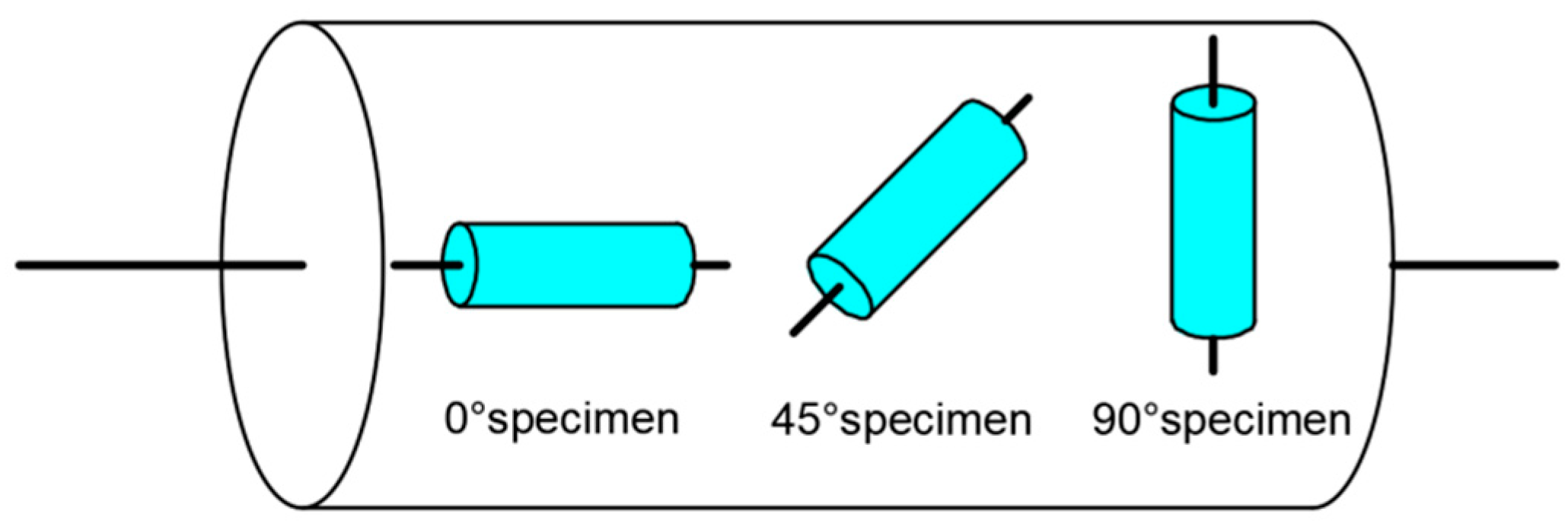
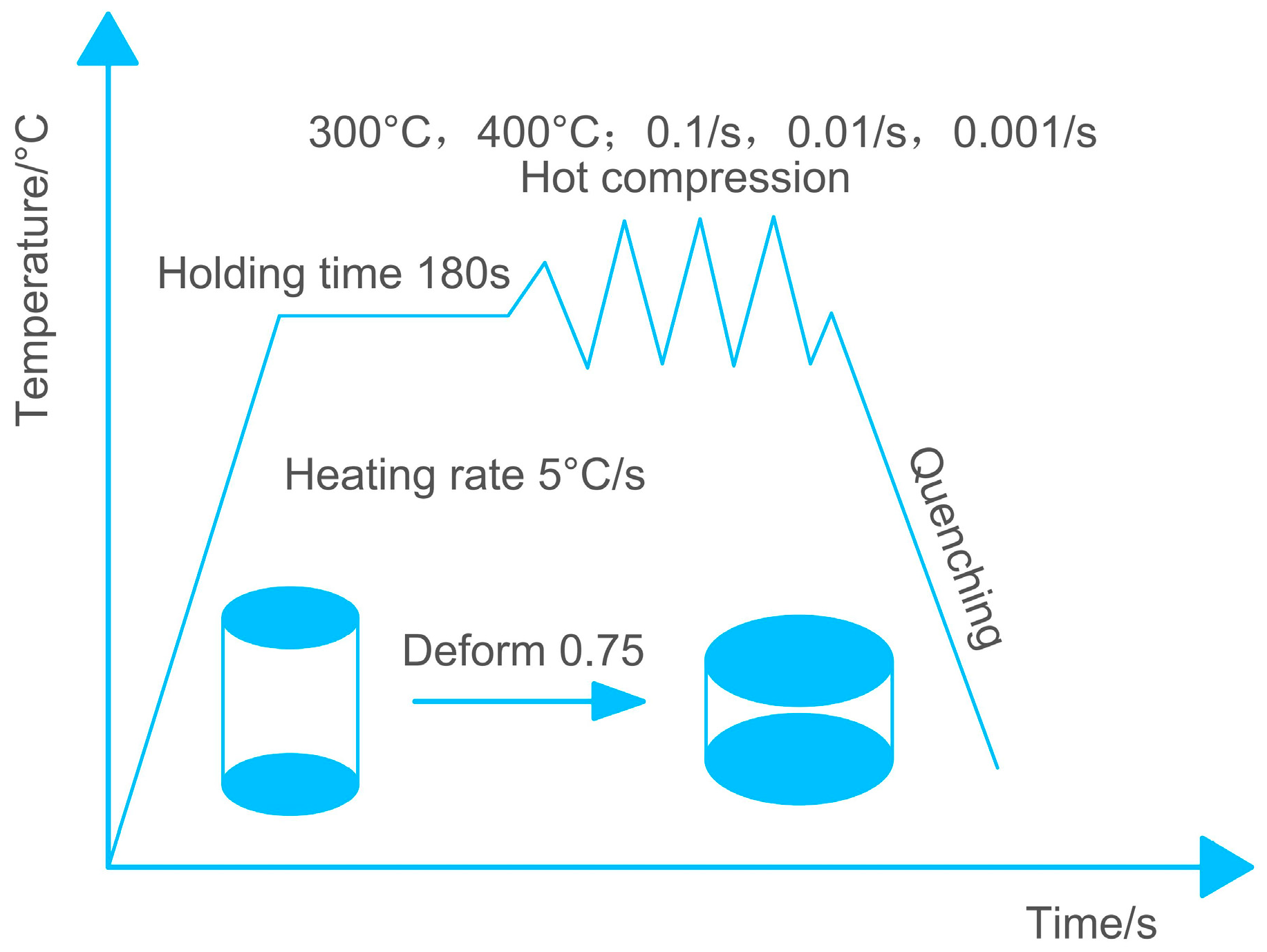

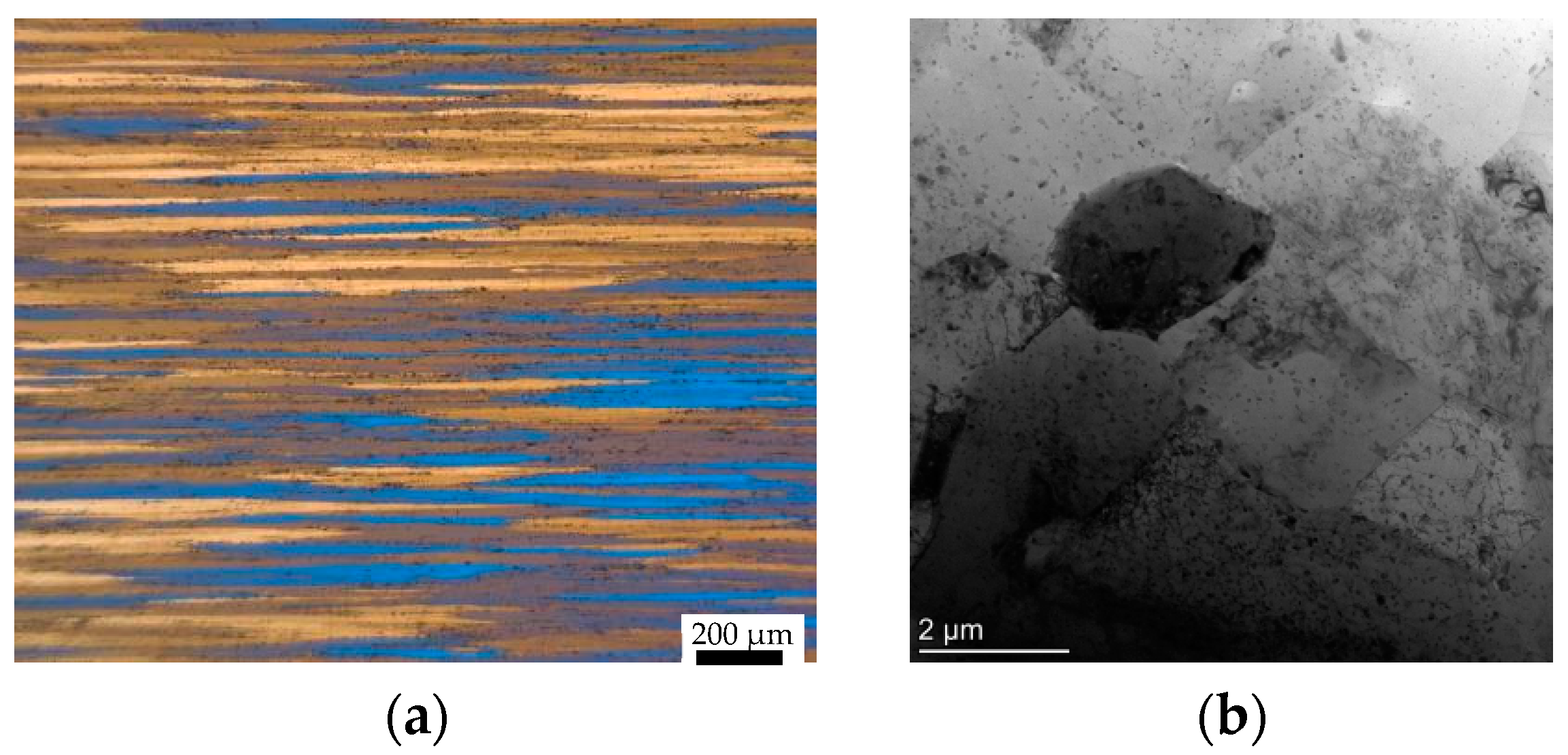
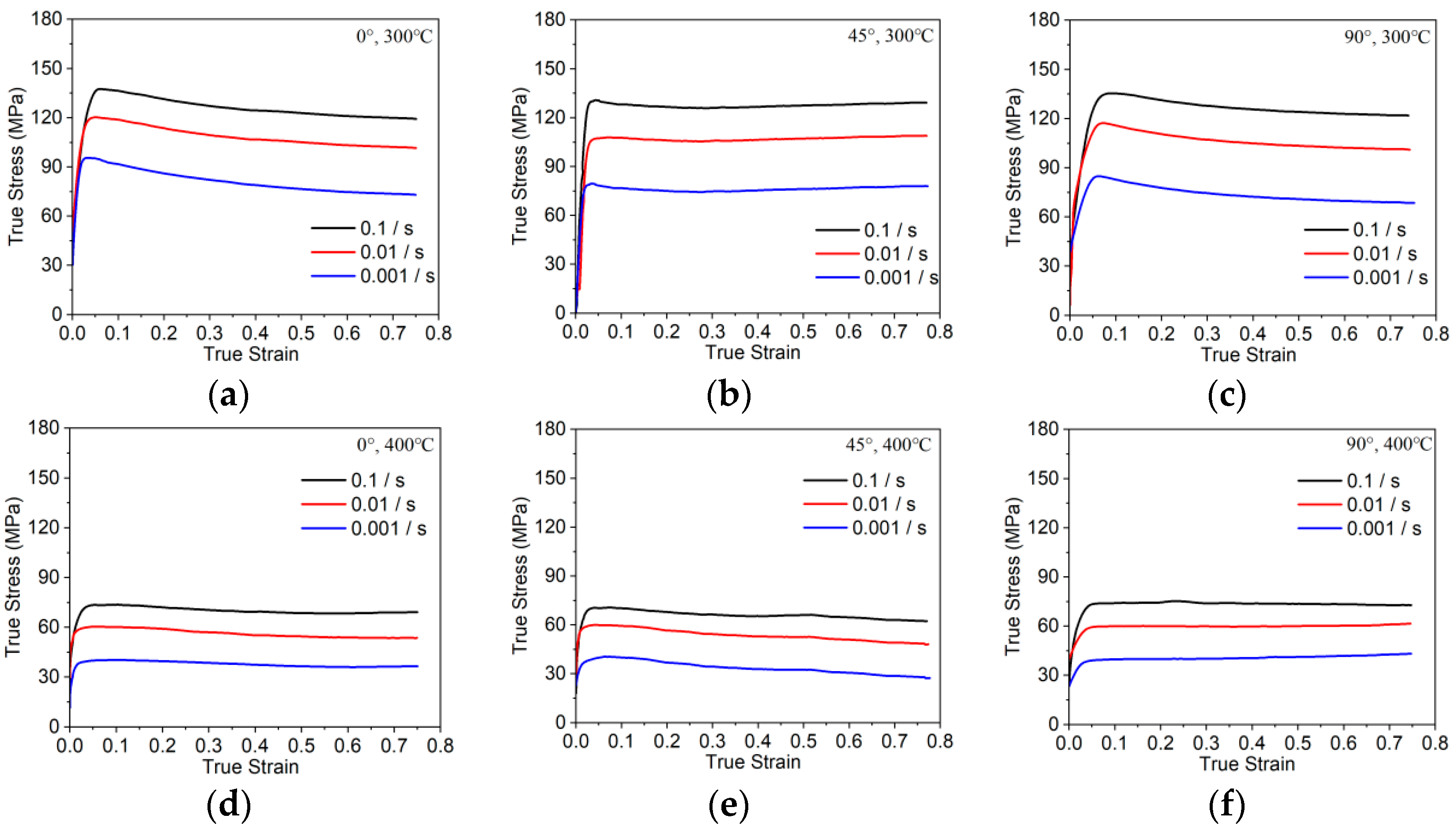
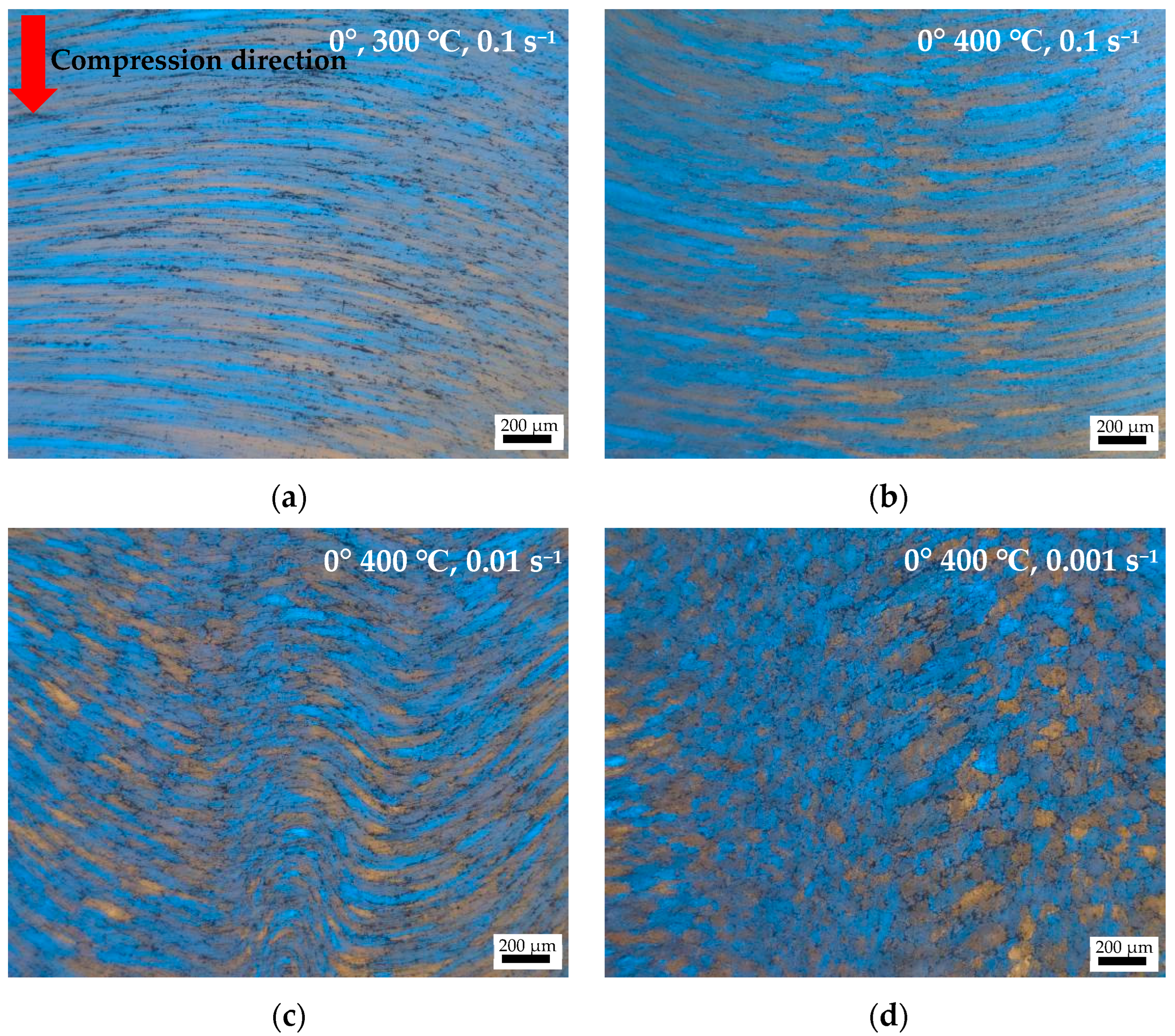
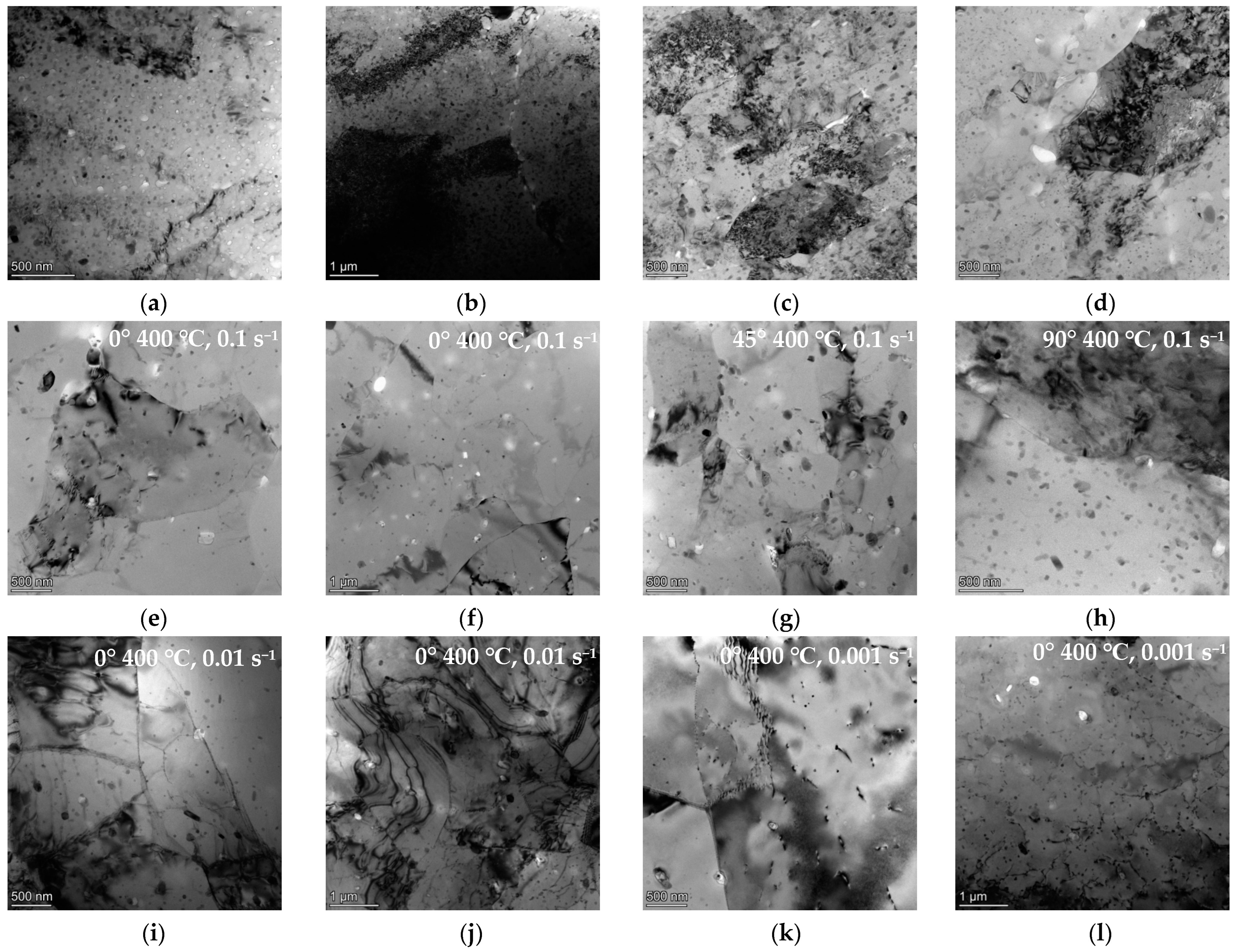
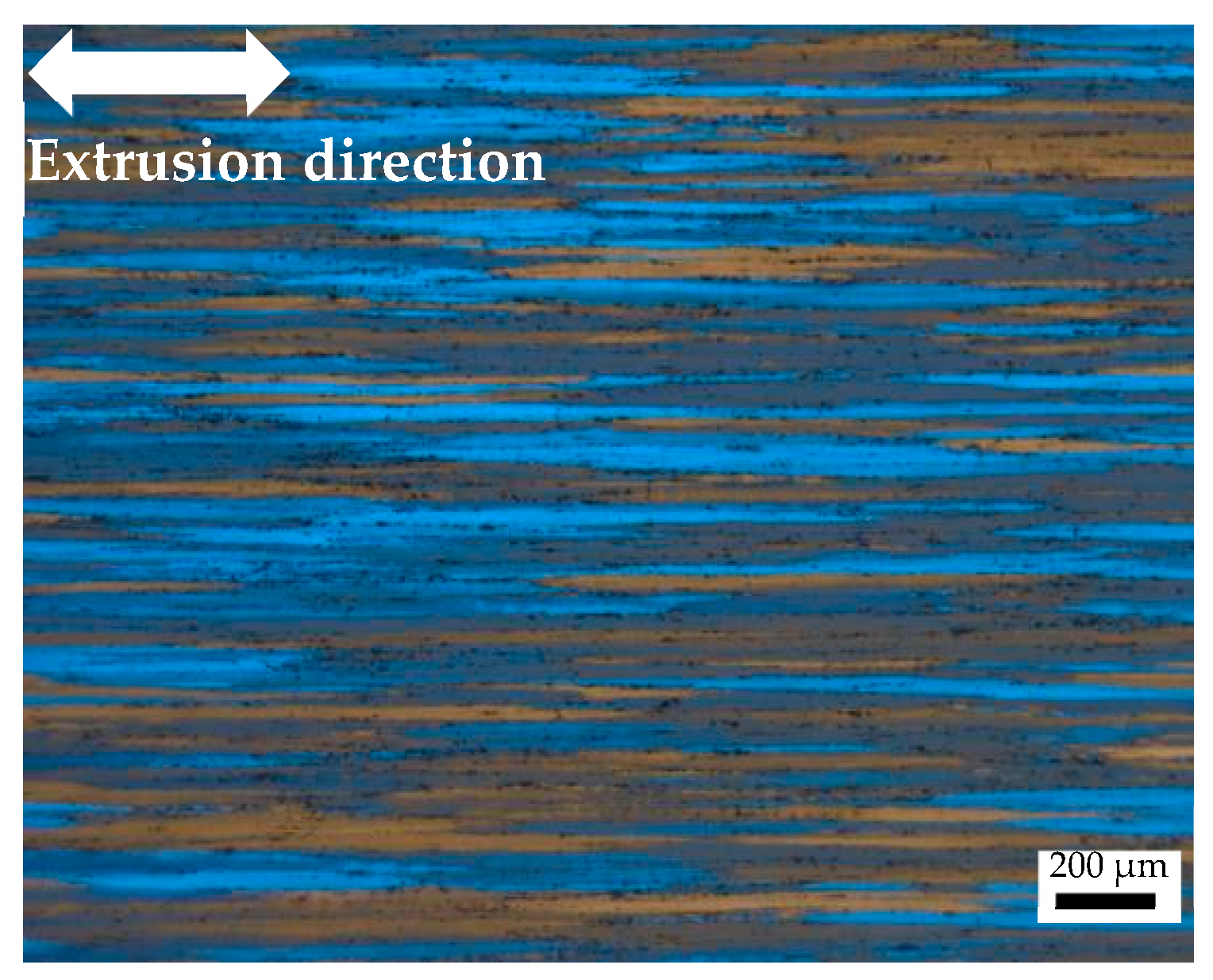
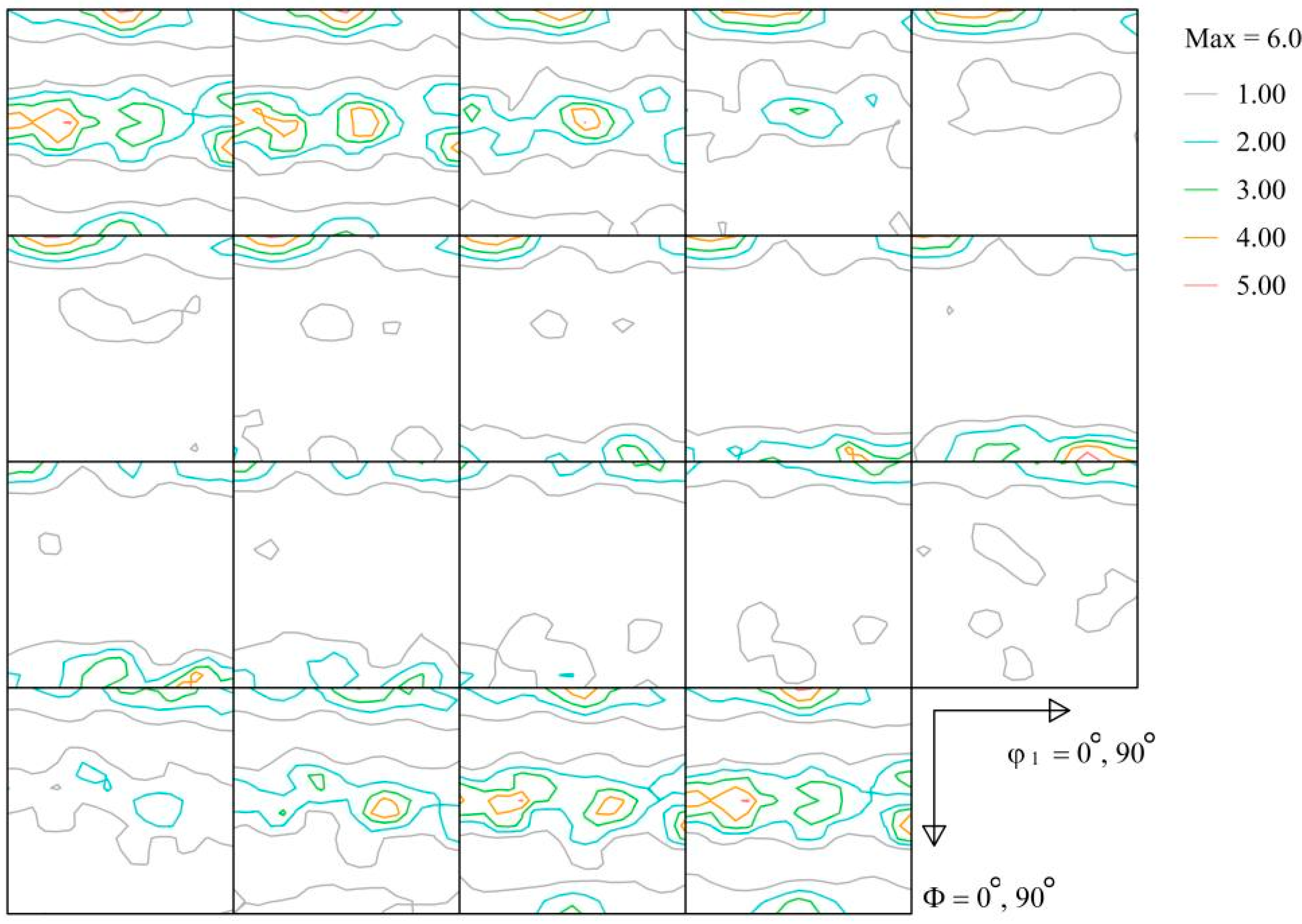
| Strain Rate/s−1 | Temperature/°C | Direction | Temperature/°C | Direction | ||||
|---|---|---|---|---|---|---|---|---|
| 0° | 45° | 90° | 0° | 45° | 90° | |||
| 0.1 | 300 | 137 | 129 | 136 | 400 | 73 | 72 | 72 |
| 0.01 | 119 | 106 | 116 | 60 | 59 | 59 | ||
| 0.001 | 95 | 79 | 84 | 38 | 38 | 38 | ||
Disclaimer/Publisher’s Note: The statements, opinions and data contained in all publications are solely those of the individual author(s) and contributor(s) and not of MDPI and/or the editor(s). MDPI and/or the editor(s) disclaim responsibility for any injury to people or property resulting from any ideas, methods, instructions or products referred to in the content. |
© 2024 by the authors. Licensee MDPI, Basel, Switzerland. This article is an open access article distributed under the terms and conditions of the Creative Commons Attribution (CC BY) license (https://creativecommons.org/licenses/by/4.0/).
Share and Cite
Ye, T.; Xia, E.; Qiu, S.; Liu, J.; Yue, H.; Tang, J.; Wu, Y. Deformation Behavior of an Extruded 7075 Aluminum Alloy at Elevated Temperatures. Materials 2024, 17, 1210. https://doi.org/10.3390/ma17051210
Ye T, Xia E, Qiu S, Liu J, Yue H, Tang J, Wu Y. Deformation Behavior of an Extruded 7075 Aluminum Alloy at Elevated Temperatures. Materials. 2024; 17(5):1210. https://doi.org/10.3390/ma17051210
Chicago/Turabian StyleYe, Tuo, Erli Xia, Sawei Qiu, Jie Liu, Huanyu Yue, Jian Tang, and Yuanzhi Wu. 2024. "Deformation Behavior of an Extruded 7075 Aluminum Alloy at Elevated Temperatures" Materials 17, no. 5: 1210. https://doi.org/10.3390/ma17051210
APA StyleYe, T., Xia, E., Qiu, S., Liu, J., Yue, H., Tang, J., & Wu, Y. (2024). Deformation Behavior of an Extruded 7075 Aluminum Alloy at Elevated Temperatures. Materials, 17(5), 1210. https://doi.org/10.3390/ma17051210






